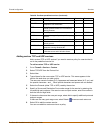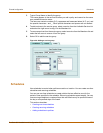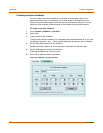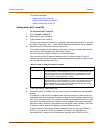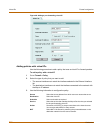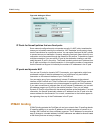
Firewall configuration Virtual IPs
FortiGate-800 Installation and Configuration Guide 209
This section describes:
• Adding static NAT virtual IPs
• Adding port forwarding virtual IPs
• Adding policies with virtual IPs
Adding static NAT virtual IPs
To add a static NAT virtual IP
1 Go to Firewall > Virtual IP.
2 Select New to add a virtual IP.
3 Type a Name for the virtual IP.
The name can contain numbers (0-9), uppercase and lowercase letters (A-Z, a-z), and
the special characters - and _. Other special characters and spaces are not allowed.
4 Select the virtual IP External Interface from the list.
The external interface is the interface connected to the source network that receives
the packets to be forwarded to the destination network.
You can select any firewall interface or a VLAN subinterface.
You can set the virtual IP external interface to any FortiGate interface. Table 39
contains example virtual IP external interface settings and describes the policies that
you can add the resulting virtual IP to.
5 In the Type section, select Static NAT.
6 Enter the External IP Address that you want to map to an address on the destination
network.
For example, if the virtual IP provides access from the Internet to a web server on a
destination network, the external IP address must be a static IP address obtained from
your ISP for your web server. This address must be a unique address that is not used
by another host and cannot be the same as the IP address of the external interface
selected in step 4. However, this address must be routed to this interface. The virtual
IP address and the external IP address can be on different subnets.
If the IP address of the external interface selected in step 4 is set using PPPoE or
DHCP, you can enter 0.0.0.0 for the external IP address. The FortiGate unit
substitutes the IP address set for this external interface using PPPoE or DHCP.
Table 39: Virtual IP External Interface examples
External Interface Description
internal To map an internal address to an address on a network connected to
another interface, VLAN subinterface, or zone. If you select internal, the
static NAT virtual IP can be added to policies for connections from the
internal interface or any zone containing the internal interface, to any
other interface, VLAN subinterface, or zone.
external To map an external address to an address on a network connected to
another interface, VLAN subinterface, or zone. If you select external, the
static NAT virtual IP can be added to policies for connections from the
external interface or any zone containing the external interface, to any
other interface, VLAN subinterface, or zone.





